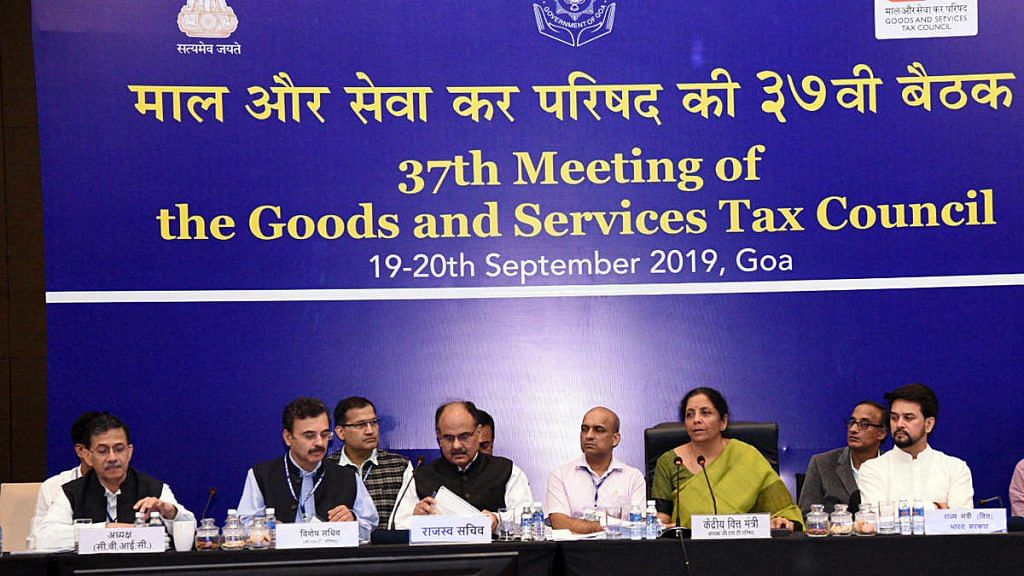Mumbai: At a time when most non-BJP-ruled states are on a warpath with the Centre on the issue of GST compensation, the Reserve Bank of India — as the debt manager of the government — should be entrusted with the fundraising, and the government should not bother how it conducts the borrowing, banking sources have told ThePrint.
“The government should be prudent while deciding its borrowing numbers. And after it decides, it should allow RBI to carry out the borrowing,” a source said.
“It should also understand that it cannot be business as usual. The market has limited resources, so it will give money at a cost which is higher than the current rates,” the source said, adding that the RBI has managed the government borrowing programme smoothly in the first half of the financial year at rates which were probably the lowest in many years.
The central government has decided not to borrow to compensate the states for the loss in revenue from GST, and has given two options to the states. In the first option, states can borrow Rs 97,000 crore, which will be entirely serviced by cess collection by the Centre. In the second option, states can borrow Rs 2.35 lakh crore, the revenue loss estimated on account of GST transition and the pandemic.
At the time of GST rollout in July 2017, the central government had assured the states of full compensation from any losses arising due to the transition to GST for a period of five years, assuming a growth rate of 14 per cent in revenues. This means that states have to be compensated until July 2022 for any losses.
Most non-BJP ruled states have so far not agreed to either of the options given by the government, and insist the Centre should borrow and compensate them.
Centre has lowest borrowing cost
Sources said it is always better for the Centre to borrow since it has the lower borrowing cost compared to states. Estimates suggest that the states’ borrowing costs are at least 50 bps (100 bps = 1 percentage point) higher than the Centre’s.
One of the reasons why the Centre does not want to borrow for the GST compensation is that yields on the sovereign paper have already hardened. The Centre has increased its borrowing for the current financial year to Rs 12 lakh crore from the budget estimate of Rs 7.8 lakh crore. In the last few days, the RBI decided to devolve bond auctions by declining to give investors demand for higher returns, indicating its resolve to keep yields around 6 per cent.
The central government is willing to offer ‘letters of comfort’ to the states so that they can get rates which are closer to what the Centre gets, but that mechanism may not lead to lower costs for the states.
“A letter of comfort is nothing but a guarantee to ensure that states can borrow the quantum they want. But such a letter will not ensure costs will be lower,” said the source.
Former Union finance minister and Congress leader P. Chidambaram also said the letter of comfort has no value, and what the states need is “hard cash”.
Also read: Why India’s bond markets are loving the GST fight between Modi govt and states
‘States have enough headroom’
The government is of the view that the states have enough headroom to borrow. Finance ministry sources said the government has already enhanced the borrowing limit from 3 per cent, which goes up to 5 per cent of the gross state domestic product (GSDP).
“On an average, the states have borrowed so far only about 1.25 per cent of the GSDP. Only a few states have reached around above 2 per cent of the GSDP. Enough headroom is available to the states to borrow according to their requirements and needs,” the Union finance ministry said.
“In any case, they will get the full compensation shortfall and therefore it is win-win-win for all — states, Centre, and the economy,” the ministry said.
The government, while justifying the decision of not borrowing for GST compensation, had said central revenues are under strain amid an increase in expenditure, not only on account of the pandemic, but also to meet the needs of national security.
“The government of India faces a very large borrowing requirement this year. Additional borrowing by the Centre influences the yields on central government securities (g-secs) and has other macro-economic repercussions,” the finance ministry had said.
“The yield on g-secs acts as a benchmark for state borrowing as well as private sector borrowing. Hence, any rise in central borrowing costs ipso facto drives up borrowing costs for all borrowers, including not only the states but also the entire private sector,” the government had argued.
Also read: Centre vs states GST row doesn’t matter. What matters is reviving economy & a borrowing plan
